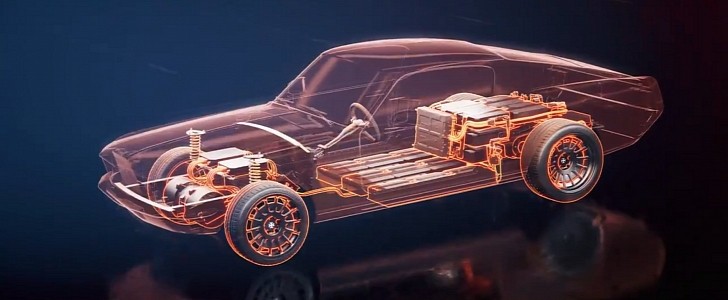When we last talked about the Electric Mustang, its name was not chosen yet. It was in June 2019, and not even the company that builds it had disclosed its full name. Charge Cars had just started the project, but most of it was defined. It certainly helps to have the body of what you intend to build, but fitting the battery pack and electric motors in this machine must have been challenging. Charge Cars offered us a first glimpse of the car’s chassis, and it is a beauty.
Although most aspects of the vehicle were already set in stone, it is interesting to see where time led us in this case. The 499 units of this EV will still start at £300,000, but that used to be $383,000 two years ago. Thanks to inflation, the same £300,000 corresponds to $410,415 at the current exchange rate. If you live in the U.S. and were planning to buy this electric machine, you must be asking why you haven’t done this earlier: you would have saved $27,415.
Yes, the Electric Mustang will still have 200 miles (322 km) of range, go from 0 to 60 mph (97 kph) in 3.9 seconds, and have a 64-kWh battery pack, but now we know how Charge Cars installed it in the Mustang body. It is not properly a battery pack, but multiple modules placed where the company managed to accommodate them. We can see nine modules under the floor, grouped in three lines of three modules.
Between them and the rear axle, the British company has placed 12 other modules in three layers of four modules arranged as a square. The rear wheel wells would not allow the company to put three modules side by side. With this arrangement, the Electric Mustang became a two-seater.
That gives us 21 modules, but there’s a final one installed behind the three layers of four modules. With 22 modules, each presents a little less than 3 kWh. It may be the case that it has precisely 3 kWh, but Charge Cars decided to give its EV a buffer to preserve the battery pack.
The Electric Mustang has four motors, one for each wheel. The motors are placed in the middle of the licensed Mustang shells Ford sells to Charge Cars, avoiding unsprung mass. They are the only thing that has been improved about the car. Together, they deliver 400 kW (536.4 hp) and 1,500 Nm (1,106.3 pound-feet). In 2019, the car had 350 kW (469 hp) and 1,200 Nm (885 lb-ft). It is strange that it goes from 0 to 60 mph spending the same time: the new motors probably emerged to ensure the car would achieve that goal.
The video below presents two distinct vehicles. One looks like Eleanor, while the second is way more discrete. The electric replica of the “Gone in 60 Seconds” star shows that the £300,000 price tag can increase by a wide margin depending on the pockets and creativity of the customer. The company still has a working reserve button on its website, which means it has not sold all 499 units of its car.
Yes, the Electric Mustang will still have 200 miles (322 km) of range, go from 0 to 60 mph (97 kph) in 3.9 seconds, and have a 64-kWh battery pack, but now we know how Charge Cars installed it in the Mustang body. It is not properly a battery pack, but multiple modules placed where the company managed to accommodate them. We can see nine modules under the floor, grouped in three lines of three modules.
Between them and the rear axle, the British company has placed 12 other modules in three layers of four modules arranged as a square. The rear wheel wells would not allow the company to put three modules side by side. With this arrangement, the Electric Mustang became a two-seater.
That gives us 21 modules, but there’s a final one installed behind the three layers of four modules. With 22 modules, each presents a little less than 3 kWh. It may be the case that it has precisely 3 kWh, but Charge Cars decided to give its EV a buffer to preserve the battery pack.
The Electric Mustang has four motors, one for each wheel. The motors are placed in the middle of the licensed Mustang shells Ford sells to Charge Cars, avoiding unsprung mass. They are the only thing that has been improved about the car. Together, they deliver 400 kW (536.4 hp) and 1,500 Nm (1,106.3 pound-feet). In 2019, the car had 350 kW (469 hp) and 1,200 Nm (885 lb-ft). It is strange that it goes from 0 to 60 mph spending the same time: the new motors probably emerged to ensure the car would achieve that goal.
The video below presents two distinct vehicles. One looks like Eleanor, while the second is way more discrete. The electric replica of the “Gone in 60 Seconds” star shows that the £300,000 price tag can increase by a wide margin depending on the pockets and creativity of the customer. The company still has a working reserve button on its website, which means it has not sold all 499 units of its car.














